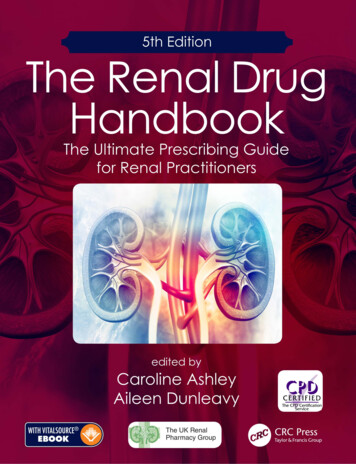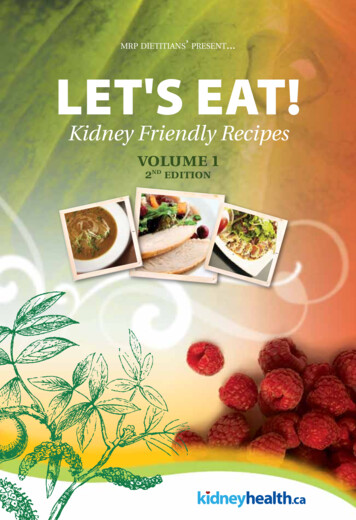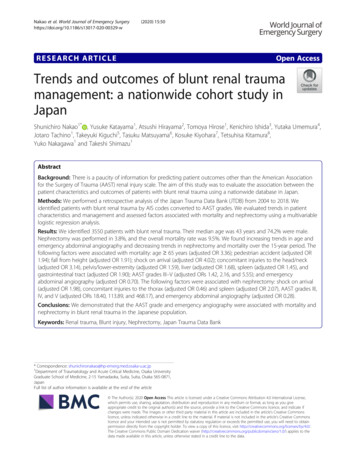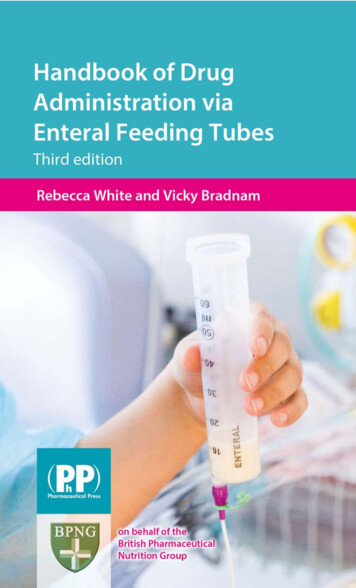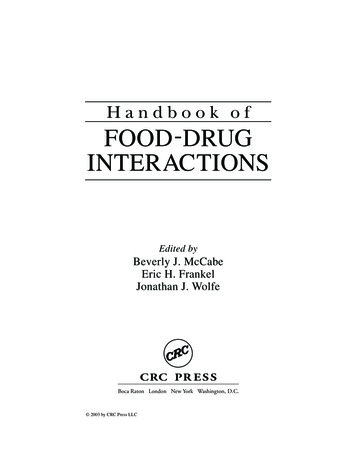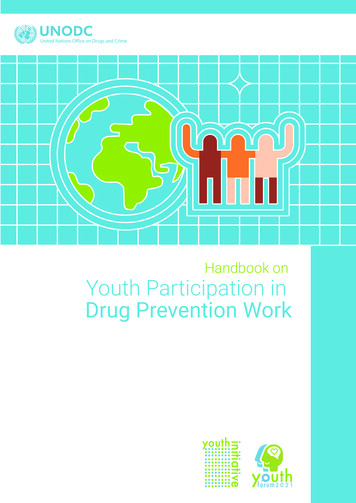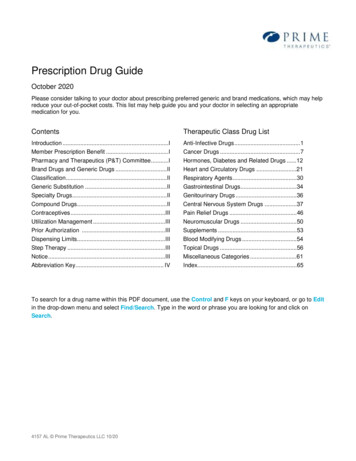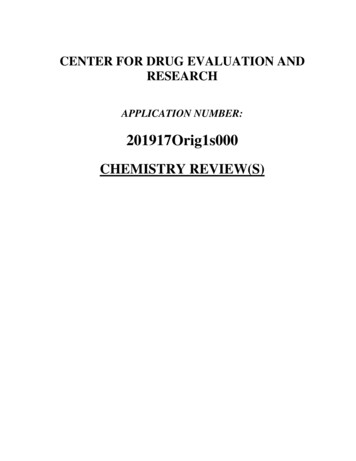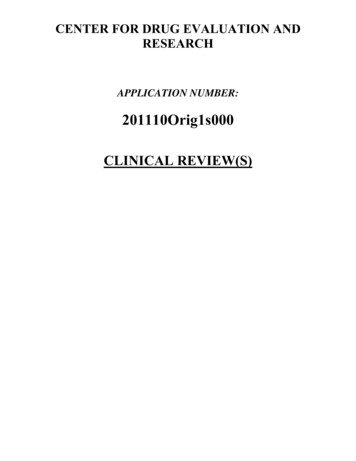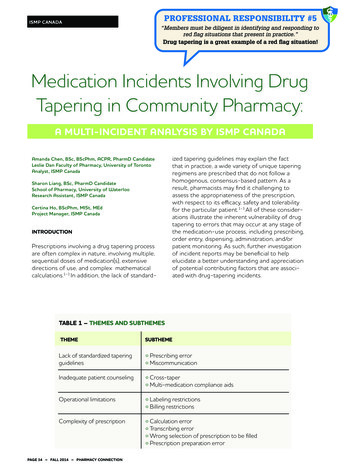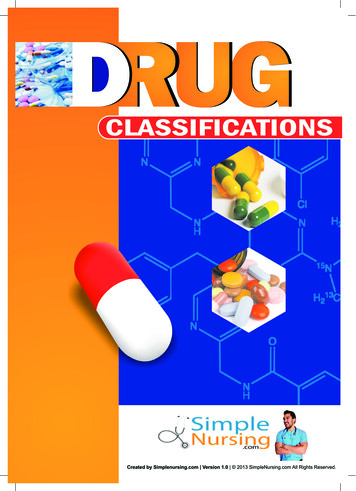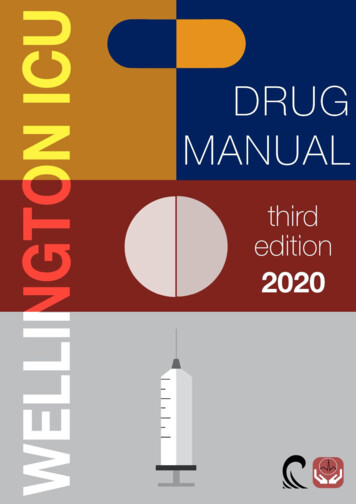
Transcription
1
The following references were used in compiling these monographs:Fink, Mitchell et al. ault.cfmTextbook of Critical Care. 5th edition 2005Ashley, Caroline and Currie, Aileen. The Renal Drug Handbook. 2nd ed. UnitedKingdom: Radcliffe Medical Press Ltd, 2004Shann, Frank. Drug Doses. 14th ed. Intensive Care Unit. Royal Children’sHospital, Parkville, Victoria 3052, Australia, 2008McClintock, Alan et al. Notes on Injectable Drugs. 5th ed. New Zealand. NewZealand Healthcare Pharmacists’ Association, 2004Medsafe Drug Data sheets (New Zealand Medicine and Medical Devices SafetyAuthority): aspMIMS Gateway: ex/An online version of this drug manual, optimised for smartphone & tabletviewing, is available at:https://drug.wellingtonicu.com/An offline version is available for download (as a PDF) from:https://forms.wellingtonicu.com/The most up-to-date version of this drug manual will always be available online.Should any discrepancies exist between the printed & online versions, the lattershould always take precedence.2
PrefaceThe first edition of the Intensive CareDrug Manual was developed by Dr. PaulYoung for use in the Intensive Care Unitin Wellington Regional Hospital in 2011.This third edition has been updated for2020 with revisions reflecting changes inour unit’s Intensive Care practice and theever-evolving critical care literature.On occasion, doses, methods ofadministration and indications differfrom those available given in theproduct information. In such cases,recommendations reflect common ICUpractice both here and elsewhere.All doses have been checkedindependently by two Intensive CareSpecialists. However if you suspect anerror, please check data with alternativesources and notify the editor.Clinical responsibility for thechoice, dose, route & frequency ofany medication always remainswith the prescribing doctor. Thismanual is for use in a monitoredcritical care environment only.Specific changes for this third editioninclude: New entries for levetiracetam, mannitol& tranexamic acid. Updated & expanded appendicesproviding more information on commondrug-related queries. New appendices on drug cost byadministration route, intravenous to oralantibiotic SWITCH, and localanaesthetic toxicity. Vancomycin dosage & monitoring hasbeen changed extensively. All drug prices have been updated asof August 2017 and are quoted are inNew Zealand dollars.Prices have been included to informprescribing choices where intravenous orenteral routes of administration areequivocal. For example, the intravenouspreparation of Acetazolamide costs 250times that of a single tablet(bioavailability 90%).Alex PsiridesWellington, New ZealandAugust 2020e: alex.psirides@ccdhb.org.nzw: wellingtonicu.comt: @psiridesThis document (c) 2020 Wellington ICU. It cannot be sold or altered without permission of the author. It ismade freely available in keeping with the principles of Free Open Access to Medical Education (FOAMEd)3
AT A B L EO lineAmlodipineAmoxicillin /AmoxycillinAmoxicillin-ClavulanicAcidAmophtericin 85052C O N T E N T SBBendrofluazideBenzylpenicillin /Penicillin G5557CCaffeineCalcitriolCalcium CarbonateCalcium ChlorideCalcium olCaspofunginCefaclorCefazolin / 6870727579828588919497CefuroximeCeliprololCharcoal (Activated)Chloral opidogrelClozapineCodeine PhosphateColchicineColoxyl with DantroleneDesmopressin / c date1871901941961992014
entinGanciclovirGentamicinGlucagonGlyceryl fenIloprostImipenemIpratropium 84287290292294296299302304307310C O N T E N T S233236239241244246Magnesium lene onidazoleMidazolamMilrinoneMorphine Sulphate &Morphine TartrateMoxifloxacinO ine ButylbromideHyoscine Hydrobromide263266268271274277279T A B L 323343365
PT A B L EParacetamolParacoxibParoxetinePethidine otassium amine SulphateT339341343345348351353356358360362364366O FWC O N T E N T SWarfarin tinSodium BicarbonateSodium NitroprussideSodium VasopressinVitamin KVerapamilQQuinaprilTazocin (Piperacillin ic 396399401436ZZopiclone439APPENDICES(page 441 onwards)1. Administration Of Medicines Via Enteral FeedingTubes2. Warfarin Reversal Guidelines3. Paracetamol Poisoning Treatment Nomogram4. Therapeutic Drug Level Monitoring5. Antibiotic Susceptibility Overview6. Opioid Dose Equivalence7. Intravenous vs Enteral Medication Costs8. Intravenous To Enteral Antibiotic Conversion9. Local Anaesthetic Toxicity10. Drug Calculations6
Wellington ICU Drug Manual v3a 2020Acetazolamide[1 vial 43.00, 1 tablet 17 cents]ADMINISTRATION ROUTES:PO, NG, IVALTERNATIVE NAMES:Diamox (Tab), Glaumox (Vial)AICU INDICATIONS:1. Diuretic (particularly in the presence of metabolic alkalosis)2. Correction of severe metabolic alkalosiscPRESENTATION AND ADMINISTRATION:PO / NG:Diamox 250 mg tablets (white); for NG use, crush prior to administration.etaIV:Glaumox is supplied as a sterile powder requiring reconstitution. Each vial contains anamount of acetazolamide sodium equivalent to 500 mg of acetazolamide.Each 500 mg vial containing acetazolamide should be reconstituted with at least 5 ml ofsterile water for injection prior to use. Reconstituted solutions retain their physical andchemical properties for 24 hours under refrigeration at 2-8 C or 12 hours at roomtemperaturezamiDOSAGE IN RENAL FAILURE AND RENAL REPLACEMENT THERAPY:No dose adjustment is required when administered for ICU indications (beware thatacetazolamide is contraindicated in the presence of metabolic acidosis).This drug is not indicated in patients on renal replacement therapy.lDOSAGE IN PAEDIATRICS:The safety and effectiveness of acetazolamide in paediatric patients below the age of12 years have not been established.oDOSAGE:For diuresis, the dose is usually 250-375 mg stat. If, after an initial response, the patientfails to continue to diurese, do not increase the dose but allow for kidney recovery byskipping medication for a day. Acetazolamide yields best diuretic results when given onalternate days, or for 2 days alternating with a day of rest.dCONTRAINDICATIONS:1. Hypersensitivity to acetazolamide or other sulphonamides2. Metabolic acidosis3. Cirrhosis (risk of development of hepatic encephalopathy)7eCLINICAL PHARMACOLOGY:Acetazolamide is an enzyme inhibitor that acts on carbonic anhydrase, the enzyme thatcatalyzes the reversible reaction involving the hydration of carbon dioxide and thedehydration of carbonic acid.
Wellington ICU Drug Manual v3a 2020WARNINGS:Fatalities have occurred, although rarely, due to severe reactions to acetazolamideincluding Stevens-Johnson syndrome, toxic epidermal necrolysis, fulminant hepaticnecrosis, agranulocytosis, aplastic anaemia, and other blood dyscrasias.PRECAUTIONS:GeneralIncreasing the dose does not increase the diuresis and may increase the incidence ofdrowsiness and/or paraesthesia. Increasing the dose often results in a decrease indiuresis.ALaboratory TestsNo tests are required in addition to routine ICU blood tests.ceDrug/Laboratory Test InteractionsAcetazolamide interferes with the HPLC method of assay for theophylline. Interferencewith the theophylline assay by acetazolamide depends on the solvent used in theextraction; acetazolamide may not interfere with other assay methods for theophylline.tazoIMPORTANT DRUG INTERACTIONS FOR THE ICU:Acetazolamide modifies phenytoin metabolism with increased serum levels ofphenytoin.Acetazolamide increases lithium excretion and the lithium levels may be decreased.Acetazolamide and sodium bicarbonate used concurrently increases the risk of renalcalculus formation.Acetazolamide may elevate cyclosporin levels.lamideADVERSE REACTIONS:Body as a Whole:Headache, malaise, fatigue, fever, pain at injection site, flushing, flaccid paralysis,anaphylaxis.Digestive:Gastrointestinal disturbances such as nausea, vomiting, diarrhoea.Hepato-Biliary Disorders:Abnormal liver function, cholestatic jaundice, hepatic insufficiency, fulminant hepaticnecrosis.Metabolic/Nutritional:Metabolic acidosis, electrolyte imbalance, including hypokalaemia, hyponatraemia, lossof appetite, taste alteration, hyper/hypoglycaemia.Nervous:Drowsiness, paraesthesia (including numbness and tingling of extremities and face),depression, excitement, ataxia, confusion, convulsions, dizziness.Skin:Allergic skin reactions including urticaria, photosensitivity, Stevens-Johnson syndromeSpecial Senses:Hearing disturbances, tinnitus, transient myopia.Urogenital:Crystalluria, haematuria, glycosuria, renal failure polyuria.Acetazolamide8
Wellington ICU Drug Manual v3a 2020Acetylcysteine[1 vial 25.53]ADMINISTRATION ROUTES:PO, NG, IVALTERNATIVE NAMES:Acetadote, ParvolexcetylPRESENTATION AND ADMINISTRATION:PO / NG:Give IV solution orallyIV:Acetadote and Parvolex are supplied as sterile solutions in 10ml vials containing 20%(200 mg/ml) acetylcysteine. Compatible with 5% dextrose. Prepare immediately beforeuse and discard any solution not used within 24 hours.Note: Section 29 drug when administered orally (requires specific notification toDirector-General of Health as unapproved route of administration)AICU INDICATIONS:1. Paracetamol overdose2. Non-paracetamol induced fulminant hepatic failureIt is not recommended for use as a preventative agent in contrast-induced nephropathy.cyDOSAGE IN ADULTSParacetamol Overdose:Guidelines changed in 2020 to a two .First infusion: 200mg/kg IV in 500 mL of 5% dextrose over 4 hoursSecond Infusion: 100mg/kg IV in 1000 mL of 5% dextrose over 16 hoursIf ongoing infusion is required, continue to repeat the second infusionstine9eFirst acetylcysteine infusionSecond acetylcysteine infusion200mg/kg over 4 hours in 500 mL 100mg/kg over 16 hours in 1000 mL5% dextrose5% dextroseWeightDose acetylcysteine (g) 0.2 xDose acetylcysteine (g) 0.1 x body(kg)body weight (kg)weight (kg)10g. Add 50 mL 20% acetylcysteine 5g. Add 25 mL 20% acetylcysteine to50to 450 mL 5% dextrose975 mL 5% dextrose12g. Add 60 mL 20% acetylcysteine 6g. Add 30 mL 20% acetylcysteine to60to 440 mL 5% dextrose970 mL 5% dextrose14g. Add 70 mL 20% acetylcysteine 7g. Add 35 mL 20% acetylcysteine to70to 430 mL 5% dextrose965 mL 5% dextrose16g. Add 80 mL 20% acetylcysteine 8g. Add 40 mL 20% acetylcysteine to80to 420 mL 5% dextrose960 mL 5% dextrose18g. Add 90 mL 20% acetylcysteine 9g. Add 45 mL 20% acetylcysteine to90to 410 mL 5% dextrose955 mL 5% dextrose20g. Add 100 mL 20% acetylcysteine 10g. Add 50 mL 20% acetylcysteine to100to 400 mL 5% dextrose950 mL 5% dextrose22g. Add 110 mL 20% acetylcysteine 11g. Add 55 mL 20% acetylcysteine to110*to 390 mL 5% dextrose945 mL 5% dextroseRun the first infusion at 125 mL/hour and the second at 62.5 mL/hour*all patients weighing 110kg should be dosed according to a bodyweight of 110kg
Wellington ICU Drug Manual v3a 2020DOSAGE IN PAEDIATRICS (less than 14 years of age)Paracetamol OverdoseFirst infusion: 200 mg/kg IV in 7 mL/kg (up to 500 mL) of 0.9% saline over 4 hoursSecond infusion: 100 mg/kg IV in 14 mL/kg (up to 1000 mL) of 0.9% saline over 16hoursceDOSAGE IN RENAL FAILURE AND RENAL REPLACEMENT THERAPYNo dose adjustment is required.AADDITIONAL DOSAGE NOTESWhere there has been a massive overdose with initial paracetamol concentrations morethan double the nomogram line, the second infusion should be 200 mg/kg andtoxicology advice should be obtained. Weight-based dosing is the same for both adults& children; the volume of diluent fluid differs for children. Saline is used as the diluentfor children due to the risk of hyponatraemia with 5% dextrose.tyCLINICAL PHARMACOLOGYParacetamol OverdoseAcetylcysteine likely protects the liver by maintaining or restoring the glutathione levels,or by acting as an alternate substrate for conjugation with, and thus detoxification of, thereactive metabolite.lcCONTRAINDICATIONS1. Hypersensitivity or previous anaphylactoid reactions to acetylcysteineyWARNINGSSerious anaphylactoid reactions, including death in a patient with asthma, have beenreported in patients administered acetylcysteine intravenously.stPRECAUTIONSGeneralThe total volume administered should be adjusted for patients less than 40 kg and forthose requiring fluid restriction (use DOSAGE IN PAEDIATRICS regimen).einLaboratory Tests:No tests are required in addition to routine ICU blood testsDrug/La
The Renal Drug Handbook. 2nd ed. United Kingdom: Radcliffe Medical Press Ltd, 2004 Shann, Frank. Drug Doses. 14th ed. Intensive Care Unit. Royal Children’s Hospital, Parkville, Victoria 3052, Australia, 2008 McClintock, Alan et al. Notes on Injectable Drugs. 5th ed. New Zealand. New Zealand Healthcare Pharmacists’ Association, 2004 Medsafe Drug Data sheets (New Zealand Medicine and Medical .
